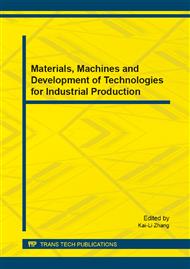p.60
p.64
p.71
p.76
p.81
p.86
p.90
p.94
p.100
Modification of Expandable Graphite and Adsorption for Methyl Orange
Abstract:
Results of preparing expandable graphite through Microwave Expansion method with the material of expandable graphite made through the Chemical Oxidation process show that in the temperature range of 700°C~900°C, the volume of expandable graphite will bigger with the rise of temperature, reaching the maximum 203 ml/g at the temperature of 900°C. The expandable graphite of 900°C can be modified in 0.5M hydrochloric acid; at the temperature of 40°C and 6h later, decolourization ratio of methyl orange will reach 95%. If the graphite is modified in concentrated nitric acid with the temperature of 50°C for 6 hours, the decolourization rate will be 96%. In terms of cost, it is more economical to modify expandable graphite in hydrochloric acid.
Info:
Periodical:
Pages:
81-85
Citation:
Online since:
August 2014
Authors:
Keywords:
Price:
Сopyright:
© 2014 Trans Tech Publications Ltd. All Rights Reserved
Share:
Citation:


